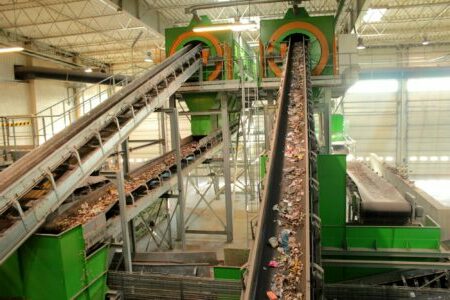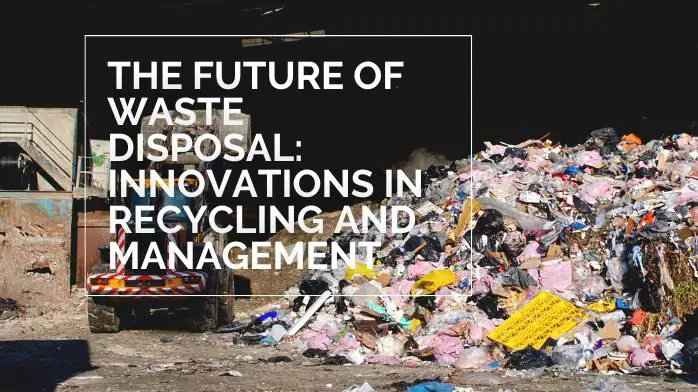Many innovative technologies and approaches are being developed and implemented to improve waste management and recycling efforts. Here are a few examples:
- Advanced recycling technologies: Some of the most promising waste management technologies enable previously difficult or impossible recycling materials. Examples include plastic-to-fuel conversion technologies, which can turn plastic waste into fuel, and chemical recycling technologies, which can break down polymers into their constituent monomers, making it possible to recycle even highly degraded plastic waste.
- Smart waste management systems: Smart waste management systems use sensors, smart bins, and other technologies to optimize the collection and processing of waste. These systems can help cities and communities to more efficiently collect and transport waste, reduce costs, and improve the overall efficiency of their waste management systems.
- Zero waste initiatives: Some communities and organizations are working towards zero waste, which means reducing the amount of waste produced to the point where it can be recycled or composted rather than ending up in landfills. These initiatives often involve a combination of education, infrastructure improvements, and incentives to encourage waste reduction and recycling.
- Circular economy approaches: The circular economy is an alternative to the traditional linear model of consumption and waste, in which resources are used and discarded. In a circular economy, resources are kept in use for as long as possible, and waste and the use of new resources are minimized. This can be achieved through the design of products and systems that enable the reuse and repair of materials, as well as the recycling of waste.
The future of waste management and recycling is likely to involve a combination of these and other approaches, as well as ongoing innovation and technological advancement.
Advanced Recycling Technologies
Advanced recycling technologies are methods of recycling that go beyond the traditional approaches of sorting, cleaning, and mechanically processing materials. These technologies can often recycle materials that are difficult or impossible to recycle using traditional methods or to do so more efficiently and effectively.
Some examples of advanced recycling technologies include:
- Plastic-to-fuel conversion technologies use chemical processes to convert plastic waste into fuel, such as gasoline, diesel, or chemicals.
- Chemical recycling technologies: These technologies use chemical reactions to break down polymers into their constituent monomers, making it possible to recycle even highly degraded plastic waste.
- Gasification and pyrolysis: These technologies use heat and chemical reactions to convert waste into synthetic gas, which can be used as a fuel or feedstock to produce chemicals.
- Advanced composting: Advanced composting technologies, such as anaerobic digestion, use microorganisms to break down organic waste into methane and other gases, which can be used as a renewable energy source.
- Metal recovery technologies use chemical and physical processes to extract and purify valuable metals from electronic waste and other sources.
Advanced recycling technologies have the potential to significantly increase the amount of waste that can be recycled and reduce the amount of waste that ends up in landfills. However, they are often more expensive and complex than traditional recycling methods, and they may also have environmental impacts that need to be carefully considered.

Smart Waste Management Systems
Smart waste management systems use sensors, smart bins, and other technologies to optimize the collection and processing of waste. These systems can help cities and communities to more efficiently collect and transport waste, reduce costs, and improve the overall efficiency of their waste management systems.
Some examples of how smart waste management systems can work include:
- Smart bins: Smart bins are equipped with sensors that can measure the level of waste in the bin and alert waste management authorities when the bin is full or almost full. This helps ensure bins are collected when needed rather than left to overflow.
- RFID tags: Radio-frequency identification (RFID) tags can be attached to waste bins or individual items of waste and can be used to track the movement and processing of waste through the waste management system.
- GPS tracking: GPS tracking can be used to track the location and movements of waste collection vehicles, allowing waste management authorities to optimize routes and improve the efficiency of waste collection.
- Predictive analytics: Predictive analytics can be used to analyze data on waste generation and collection patterns and to make predictions about future waste management needs. This can help to optimize the deployment of resources and improve the overall efficiency of the waste management system.
Smart waste management systems have the potential to significantly improve the efficiency and effectiveness of waste management, helping to reduce costs and minimize the environmental impact of waste. However, they can also be expensive to implement and maintain and may require significant investments in infrastructure and technology.
Zero Waste Initiatives
Zero waste initiatives are efforts to reduce the amount of waste produced to the point where it can be recycled or composted rather than ending up in landfills. These initiatives often involve a combination of education, infrastructure improvements, and incentives to encourage waste reduction and recycling.
Several key strategies can be used to achieve zero waste:
- Reducing consumption: One of the most effective ways to reduce waste is to reduce the number of resources consumed. This can be achieved through initiatives such as reducing packaging, encouraging the use of reusable products, and promoting the repair and reuse of products.
- Increasing recycling and composting: By increasing the amount of waste that is recycled and composted, it is possible to reduce the amount of waste that ends up in landfills. This can be achieved through infrastructure improvements, such as the provision of recycling bins and composting facilities, as well as through education and outreach programs.
- Implementing producer responsibility policies: Producer responsibility policies place the responsibility for the end-of-life management of products on the producers of those products. This can incentivize producers to design products that are easier to recycle and to fund recycling and waste management infrastructure.
- Adopting circular economy approaches: The circular economy is an alternative to the traditional linear model of consumption and waste, in which resources are used and discarded. In a circular economy, resources are kept in use for as long as possible, and waste and the use of new resources are minimized. This can be achieved through the design of products and systems that enable the reuse and repair of materials, as well as the recycling of waste.
Zero waste initiatives can help reduce waste’s environmental impact while providing economic and social benefits such as reduced resource consumption, job creation, and improved public health.
Circular Economy Approaches
The circular economy is an alternative to the traditional linear model of consumption and waste, in which resources are used and discarded. In a circular economy, resources are kept in use for as long as possible, and waste and the use of new resources are minimized. This can be achieved through the design of products and systems that enable the reuse and repair of materials, as well as the recycling of waste.
Several key strategies can be used to transition to a circular economy:
- Design for reuse and repair: By designing products and systems that are easy to repair and reuse, it is possible to extend their useful lives and reduce the need for new resources. This can be achieved through modular design, standardized components, and other approaches.
- Product-as-a-service models: Instead of selling products, companies can offer products as a service, which allows them to retain ownership of the product and ensure that it is used and maintained efficiently. This can also encourage using high-quality, durable products designed for reuse.
- Recycling and recovery: By improving the efficiency and effectiveness of recycling and recovery systems, it is possible to close the loop on resource use and reduce the need for new resource extraction. This can be achieved through the use of advanced recycling technologies, as well as through policies and incentives that encourage recycling and waste reduction.
- Resource efficiency: By using resources more efficiently, it is possible to reduce the demand for new resources. This can be achieved through the use of energy-efficient technologies, the adoption of sustainable practices, and the promotion of resource-efficient products and services.
The circular economy has the potential to significantly reduce the environmental impact of resource use while also providing economic and social benefits such as reduced resource consumption, job creation, and improved public health.
Conclusion
Waste management and recycling are important issues that have significant environmental, economic, and social impacts. Many innovative technologies and approaches are being developed and implemented to improve waste management and recycling efforts, including advanced recycling technologies, smart waste management systems, zero waste initiatives, and circular economy approaches.
These approaches have the potential to significantly increase the amount of waste that can be recycled, reduce the amount of waste that ends up in landfills, and minimize the environmental impact of waste. However, they also often involve significant investments in infrastructure and technology and may have environmental impacts that must be carefully considered.

